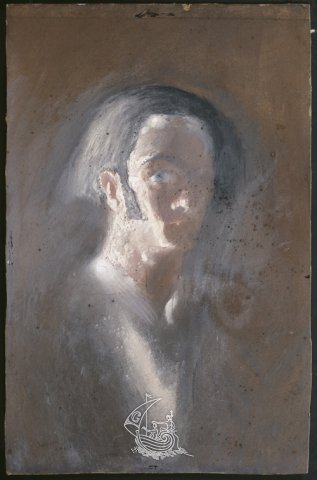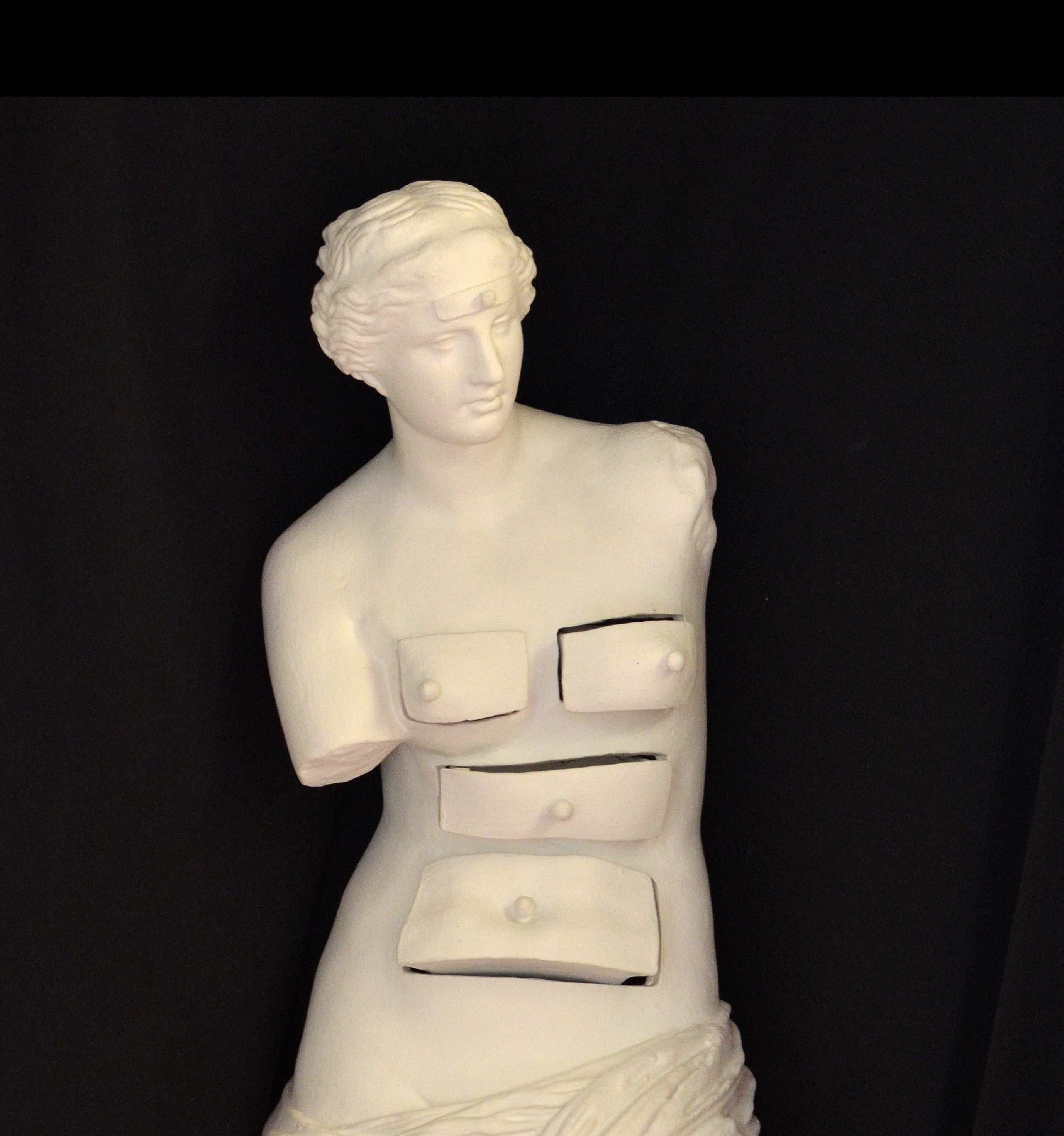The Gala-Salvador Dalí Foundation presented at the Dalí Theatre-Museum of Figueres three works on temporary loan from the Salvador Dalí Museum of Saint Petersburg (Florida, United States).
The inauguration ceremony was attended by Montse Aguer, Director of the Centre for Dalinian Studies, and Antoni Pitxot, Director of the Dalí Theatre-Museum, both trustees of the Dalí Foundation. On the occasion of the loan of a painting entitled Self-Portrait, a small-format exhibition has been organized around this theme in Salvador Dalí's oeuvre. The work can be seen in the Dalí d'Or Room (antecrypt), accompanied by other Salvador Dalí self-portraits that belong to the Dalí Foundation's collection. Both the exhibition and the works on loan from the museum of Florida can be seen until 10 February 2008.
Previous exchanges of works
With the loan of the oil painting entitled Gradiva Rediscovers the Antropomorphic Ruins (Retrospective Fantasy), ca1931-32 from the Museo Thyssen-Bornemisza of Madrid in January 2008 , and the exhibition dedicated to Anna Maria Dalí, the Foundation embarked upon a policy of exchange of the artist's works with other museums and with private collections.
The works that are travelling from Figueres to Florida
In that regard , the Foundation has now granted on temporary loan to the Salvador Dalí Museum of Saint Petersburg (Florida, United States) the three oil paintings entitled Three Women Imitating the Movements of a Sailing Boat, 1940, Saint Cecilia Ascensionist, 1955, and Untitled. The Swallow's Tail - Series on Catastrophes, 1983. From the American museum the Foundation has received in counterpart the works Self-Portrait, ca 1921, Figure on the Rocks, 1926 and Dionysus Spitting the Complete Image of Cadaqués on the Tip of the Tongue of a Three-Storeyed Gaudinian Woman, 1958.
A small-scale exhibition dedicated to self-portraits
On the occasion of the loan of Self-Portrait, ca 1921, the Foundation put together a small selection of oil paintings and drawings around this theme. All along the history of art, many artists have at some time painted themselves, and Dalí is no exception. Self-portraits are works of special interest, since they reveal an intention - the image the artist wishes to convey of himself. They are an attempt at self-affirmation on both personal and artistic level. In the exhibition presented here we can see some of the self-portraits that Dalí made over the course of his life, such as Self-Portrait with Raphaelesque Neck, ca 1921; Self-Portrait, ca 1921 (Salvador Dalí Museum, St. Petersburg); Self-Portrait with "L'Humanité", 1923; Self-Portrait Splitting into Three, 1926-27; Soft Self-Portrait, 1941 and the twin-parts stereoscopic work Dalí from the Back Painting Gala from the Back Eternalised by Six Virtual Corneas Provisionally Reflected in Six Real Mirrors, 1972-73.
Dalí started to paint self-portraits very early on . In the ones made during adolescence, Dalí represents himself with a distant attitude towards his companions, but at the same time wishing to make an impact on them (or to provoke them) and on the public in general. Like other adolescents, he sought through his appearance an affirmation of his own personality, wearing long hair and sideburns, and dressing extravagantly. In his autobiography The Secret Life, he himself explains the meaning of one of his best-known self-portraits: "I'd let my hair grow, and wore it long like a girl's hair. Looking at myself in the mirror I would often strike the poses and melancholy appearance of Raphael, to whom the greater resemblance I bore the better, as far as I was concerned. I also awaited with impatience the sprouting of hair on my face so that I could shave and sport some good long sideburns. I wanted to give myself a 'weird appearance' as soon as possible, to compose a masterpiece with my own head". And he continues his explanations saying "I bought a large black felt hat, and a pipe which I did not smoke and never lighted, but which I kept constantly hanging from the corner of my mouth. I loathed long trousers, and decided to wear short pants with stockings, and some puttees. On rainy days I wore a raincoat I'd brought from Figueres, but so long that it nearly reached the ground. I would wear the big black hat with that raincoat, my hair emerging from either side like a mane. I now realise that those who knew me at the time were not exaggerating when they said that my appearance was 'fantastic'. For indeed it was. Whenever I came out of my room or went back to it, groups of busy bodies would gather to see me go by. And I would continue on my way with my head high, puffed up with pride."
Accordingly, in Self-portrait with Raphaelesque Neck Dalí is staring at the spectator in an almost severe manner. As the title announces, this oil painting is a homage to one of his favorite painters, Raphael, whose self-portrait was very familiar to Dalí, since it was reproduced on the frontispiece of a book about that artist in the Gowans collection, which Dalí had in its entirety.
In both the Self-Portrait dating from 1921 and belonging to the Gala-Salvador Dalí Foundation, and the one dating from ca 1921 from the Salvador Dalí Museum of Saint Petersburg , the artist represent himself in profile, looking at us, though in the second portrait, one of his eyes is hidden. This pose, while permitting a magnificent study of light and chiaroscuro, cannot conceal a certain arrogance, not to mention the iconographic connotations of the eye through the history of art and in Dalí's oeuvre.
In Self-Portrait with "L'Humanité", Dalí painted himself dressed as a worker and wishes to represent himself in a rebellious and provocative attitude, with a collage from the communist daily newspaper L'Humanité, which seems to bear out his declared admiration for the idea of revolution. The oil painting itself dates from 1923, although the clipping from newspaper added to the cardboard is dated 24 July 1928. The influence of Rafael Barradas is clear, both in the geometrical structures of the paintings - background of the studio, the newspaper itself- and in the schematic definition of the features in the self-portrait -eyebrows, eyes and sideburns-
In the second half of the 1920s, after the visit he paid to Picasso in 1926, where he was able to see the latest Cubist paintings by the Málaga painter, Dalí's own painting underwent a major change. This is the period of his Self-Portrait Splitting into Three. Referring to that painting later in 1962, he said: "Painting a trinitary self-portrait. The painter has to have three eyes; that third eye is today confirmed by the electrocular monocle". The two self-portraits that close the exhibition are well-known: Soft Self-Portrait, also called Soft Self-Portrait with Fried Bacon, and the stereoscopic Dalí from the Back Painting Gala from the Back Eternalised by Six Virtual Corneas Provisionally Reflected in Six Real Mirrors.
Dalí defines his Soft Self-Portrait as an antipsychological self-portrait, for instead of painting the soul or interior he painted only the exterior, the wrapping, "the glove of myself". But that glove is edible and even beginning to decay, which is why there are ants on the bacon. With this painting, he considers himself the most generous of painters, since he offers himself to be eaten, "thus providing our epoch with succulent nourishment". In Dalí from the Back Painting Gala from the Back Eternalised by Six Virtual Corneas Provisionally Reflected in Six Real Mirrors, a stereoscopic painting made up of two elements and created by the painter in 1972-73, we see an example of the many stereoscopic experiments Dalí carried out during the 1970s. Like in the work by his admired Velázquez, Las Meninas, Dalí is shown painting a portrait of Gala from the rear, with both of them reflected in a mirror.
These paintings are accompanied by some of the preparatory drawings. The other two works on temporary loan from the Florida Museum - Dionysus Spitting the Complete Image of Cadaqués on the Tip of the Tongue of a Three-Storeyed Gaudinian Woman and Figure on the Rocks, can be seen in the Treasure Room The second goes hand in hand with the Dalí Foundation work entitled Figures Lying on the Sand, 1926.









